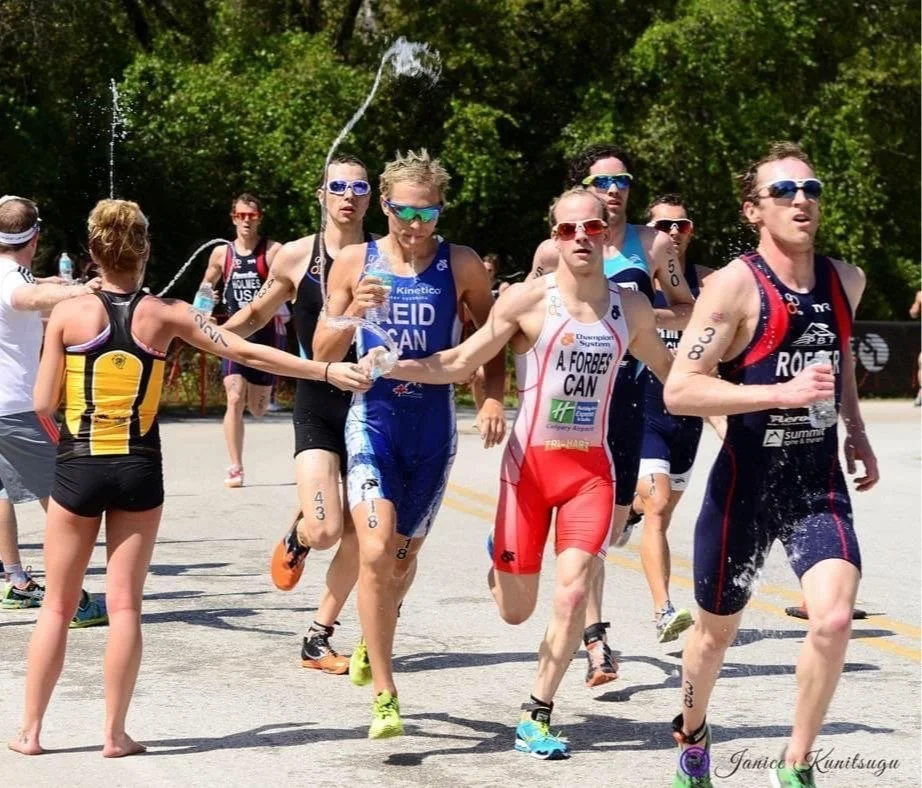🌡️ Heat Training Considerations for Runners
One of the most common problems I see as a coach during the summer is runners ruining their fitness or racing by chasing the wrong metrics. You might have the right running watch, but you are looking at the wrong numbers.
As a running and triathlon coach with a background in exercise science, these principles will help you train, perform, and thrive through the Midwest heat wave. Listening to your body, communicating with your coach, and ignoring slower paces during the heat will ultimately lead to great racing results.
Here’s a breakdown on adapting your training, refining your pacing, and maximizing performance (and safety) when temperatures soar.
Heat Acclimatization
Physiological Adaptations:
Repeated exposure to hot conditions leads to lower resting and exercising heart rates, increased plasma volume, improved sweat rate, and earlier onset of sweating—all mechanisms that help your body shed heat more efficiently and maintain a lower core temperature during exertion.
Acclimatization Timeline:
Athletes can notice adaptations within 7–14 days of regular training in the heat—aim for gradual increases in duration and intensity (start with short, easy sessions and add volume every few days). Those who have trained at high altitude can use a similar strategy for high heat and humidity.
Benefits:
Heat acclimation lowers the risk of heat illness, reduces perceived effort at a given workload, and directly improves performance when racing or training in high temperatures.
Heart Rate Increases in Heat
Cardiovascular Strain:
In hot environments, more blood is diverted to the skin for cooling (aka sweating), which reduces stroke volume and forces a rise in heart rate at a given pace. Another term you may have heard for this is “cardiac drift.” Again, give yourself that 7-14 day window to adapt. Now is not the time to crush the paces at the risk of ruining your long term goals.
Pacing Implications:
When it’s 90°F+ with humidity, it's common for runners to see their heart rate rise by 10–20 bpm or more, even if pace and perceived effort remain steady. Trying to run the same paces in training or racing in the heat and humidity can lead to BIG problems. I would advise all runners to use heart rate as a guide rather than paces in hot and humid environments.
Consider Testing If Racing in Heat and Humidity
Assessment Strategies:
Conduct a threshold or field test in hot conditions—this could be a time trial or a lab-based lactate threshold assessment performed after acclimatization—to identify your new training zones.
Use a Training Calculator:
There are a multitude of training calculators that can help you adjust your training paces from the perfect 45–55 degree days to the now 90+°F conditions. DM me for a few of my favorites!
Zone Shifts:
Expect heart rate zones to shift upwards by 10–15 bpm or more for typical aerobic and tempo intensities in extreme heat. But avoid moving every zone up 10–15 bpm, or overtraining, plateaus, or injuries will soon follow!
Monitoring and Adjusting
Continuous Assessment:
Behind the scenes, with all the athletes I work alongside, we do regular heart rate checks and rate of perceived exertion (RPE) to ensure you’re not pushing beyond sustainable limits.
Coaching Approach:
With the athletes I work with, we use a more proactive approach: if heart rate spikes or recovery lags, we reduce pace, add walk breaks, shorten sessions or intervals, or move workouts to cooler times or even treadmills.
Heart Rate Too High, Too Long:
If heart rate (resting and workout) is higher day-to-day for a given effort, it could be giving you early warning signs. The following are possible: light to moderate dehydration, insufficient recovery between training sessions, or the onset of an upcoming illness.
Hydration and Electrolytes Guidance
Fluid Balance:
Sweat rates increase dramatically—some runners lose 1–2 L/hour or more. Aim to replace fluids roughly at the rate of loss, using body weight checks (before/after runs) as a guide. There are plenty of at-home sweat loss tests runners can perform to learn more about how much fluid they lose per hour. DM me for a DIY home sweat test.
Electrolytes:
Sodium loss is huge in hot, humid conditions. Lack of sodium prep or replacement can increase the risk of cramping and will ultimately negatively impact performance. I recommend using electrolyte-based drinks or supplements, especially on runs over 60–90 min or if you’re a ‘salty sweater’ (visible salt stains, cramping history).
Strategies:
Start runs hydrated, drink steadily throughout (lighter, smaller sips are preferred over downing an entire 20 oz between intervals), and weigh in after to confirm fluid deficit is below 2% of body weight per session. Think about consuming water like an IV drip versus pouring a bucket of fluids in all at once.
Listen to Your Body & Communicate With Your Coach
Individualization:
Runners vary in heat tolerance due to genetics, fitness, experience, and acclimatization status. Similar to training in the cold or at high altitudes, your body can adjust over time with proper periodization.
Modifications:
Adjust runs on the fly: move workouts indoors, substitute cross-training, shorten sessions, increase rest between reps, or do a little of everything.
Thanks for taking the time to learn more about heat training! DM me for specific pacing calculators or home sweat test.



